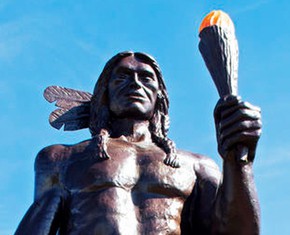The views expressed in our content reflect individual perspectives and do not represent the authoritative views of the Baha'i Faith.
In my Christian upbringing, I was never taught how Christianity was spread by force throughout much of Europe and Asia, nor was I made aware of the early church’s obsession with doctrine. These realities would not be so concerning if they were simply isolated early events. It seems, however, that they were not. Forced conversions, persecutions, and removal of non-Christians from lands under Christian rule continued to occur throughout the newly “Christianized” Roman Empire.
RELATED: When Constantine Converted to Christianity
After Constantine, another Roman emperor, Theodosius, signed an order in 381 that went beyond what any future Muslim ruler would ever do: it forced conversion to one brand of Christianity.
The edict from Theodosius and his two co-Emperors reads:
We the three emperors will that all of our subjects follow the religion taught by Saint Peter to the Romans, professed by those saintly prelates Damasus Pontiff of Rome, and Peter Bishop of Alexandria, that we believe the one divinity of the Father, Son and Holy Spirit, of majesty coequal, in the Holy Trinity. We will that those who embrace this creed be called Catholic Christians; we brand all the senseless followers of other religions by the infamous name of heretics and forbid their conventicles to assume the name of churches; we reserve their punishment to the vengeance of heaven, and to such measures as divine inspiration shall dictate to us.
Forced conversion to particular Roman brands of Christianity was not simply imposed on idolaters; it was executed upon large portions of the population who had different Christian theological views or even different religions.
The Baha’i teachings outlaw any form of forced conversion. Baha’u’llah, the prophet and founder of the Baha’i Faith, counseled all Baha’is against causing “harm to anyone among mankind:”
Strife and conflict befit the beasts of the wild. … Indeed through the power of good words, the righteous have always succeeded in winning command over the meads of the hearts of men. Say, O ye loved ones! Do not forsake prudence. Incline your hearts to the counsels given by the Most Exalted Pen and beware lest your hands or tongues cause harm unto anyone among mankind.
Beware lest ye shed the blood of anyone. Unsheathe the sword of your tongue from the scabbard of utterance, for therewith ye can conquer the citadels of men’s hearts. We have abolished the law to wage holy war against each other. God’s mercy, hath, verily, encompassed all created things, if ye do but understand.
Of course, Christ also asked his followers to turn the other cheek. However, the senior patriarchs of the Catholic Church took a while to gather theological arguments in support of forced conversion, but eventually, they got around to it.
Aurelius Augustinus (354-430 CE), who eventually became the Bishop of the North African city of Hippo and the well-known Saint Augustine, was perhaps more significant than any Roman emperor in the development of the doctrine that sanctioned the use of force in Christianity. Augustine understood the opportunity that having a Christian emperor afforded. As he gained power, he formulated two doctrines of enormous import:
- He advanced the idea that the promised millennium had arrived, and that Christ’s rule had come to Earth through the influence of God’s chosen regent, the Emperor, and
- that people could be forced to enter the church because it was, in the end, better for them.
Called the doctrine of cogite intrare, whose authority ostensibly comes from a passage in Luke (14:23), Augustine used it in a letter to assert that it is permitted to force people — in this case, a Christian group called the Donatist — to adhere to the true Catholic faith, because:
… the thing to be considered when any one is coerced, is not the mere fact of the coercion, but the nature of that to which he is coerced, whether it be good or bad:
RELATED: Bad Religion: When the End Justifies Any Means
This, of course, is that troublesome “end justifies the means” argument. Augustine continued, by asserting:
In all these cases, what is important to attend to but this: who were on the side of truth, and who on the side of iniquity; who acted from a desire to injure, and who from a desire to correct what was amiss?
Using this logic, Church doctrine claimed that force can be used if you feel you are on the side of truth. But who decides what is truth and when the means justify the ends? It’s a slippery slope indeed!
In 431, Theodosius II called together the First Council of Ephesus and had the Bishop of Constantinople, Nestorius, condemned as a heretic because he found the term “mother of God” (Theotokos) when applied to Mary objectionable, and because he felt that Jesus had both human and divine natures. A few years later, on November 14, 435 Theodosius II also instituted the death penalty for all “heretics” and pagans. Heretics, in this case, included anyone who would not accept the emperor’s theology. Fearing murder, many Nestorians migrated east, mainly to Persia, while those of other unorthodox beliefs converted, ran, or went underground with their faith. In 451, those who held Nestorian views were again condemned as heretics at the Council of Chalcedon, which, somewhat paradoxically, confirmed that Jesus was “truly God and truly man,” a hairsplitting difference from what Nestorians actually believe.
This history of the use of force and violence in religious conversion is not limited to Christians, but it certainly came about in this early period of Christianity when papal authority and state government became one and the same. In “Some Answered Questions,” Abdu’l-Baha condemned such violence and hypocrisy:
Christ did not harm anyone, but certain popes put many innocent souls to death. Refer to the history books. How much blood have the popes spilled merely to assert their temporal authority! How many thousands of servants of humanity, among them learned men who had discovered the mysteries of the universe, have they tortured, imprisoned, and slain, all for mere differences of opinion! How vehemently have they opposed the truth! …
Our meaning is that the instructions of Christ are one thing and the conduct of the papal government is quite another: They do not agree in the slightest.
… when the means of temporal sovereignty were secured, the papal government entirely forgot Christ and occupied itself with earthly dominion and grandeur, with material comforts and luxuries. It put people to death, opposed the diffusion of learning, persecuted men of science, obstructed the light of knowledge, and gave people the order to slay and pillage.
Who knows, I’ve often wondered, whether my own ancestors were forced to convert to Christianity under threat of violence, torture, or death? For this reason alone, I wanted to know more, and that process of gaining knowledge eventually led me to the Baha’i Faith. Those powerful teachings explain why such terrible things happen in the name of religion, and how we can stop them by understanding the evolution of God’s ancient plan.
















Comments
Sign in or create an account
Continue with Googleor